I had the same problem sometimes, but what I did was: I always use paper towel, I use thin layers of CA, so not to much on the towel, I try as much as possible to start applying from the opposite side of the thread towards the thread, so the amount of CA at the threaded end is smaller. Every 2-3 layer I try remove the tape from the thread, in this way the layer of CA which inevitably will run over the tape will easily brake without damaging the CA on the pen. Finally, after almost each layer I try cleaning the edge of the pen, where the wood finishes and the threaded insert starts, with a small piece of clean towel. Be careful in this case, the extra CA you will clean it from that area might goes back over the end of the wood and you'll end up with a very small shoulder of CA right where the wood ends., which you'll have to remove it, either by sanding it, or by applying more CA on the rest of the wood so will become level. I hope I was not too confusing in my explanations. These are valid for the barell, for the cap is easier, you may want to have a suitable mandrel with a M13(14 etc) threaded tenon in which you will fix the cap, ideally avoid having a flush passing from the cap to mandrel body, otherwise you'll glue them together. The extra CA which will form at the end of the cap you'll sand it later, just hold the cap vertical over a 120 grit sand paper and make round movements without any pressure, clockwise and counterclockwise.



